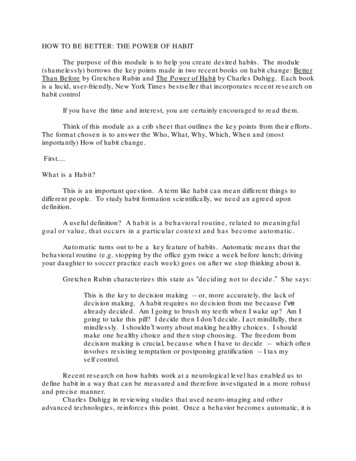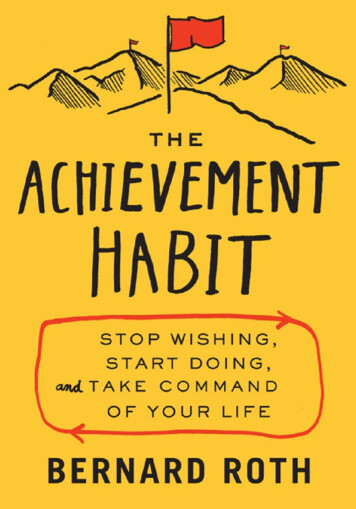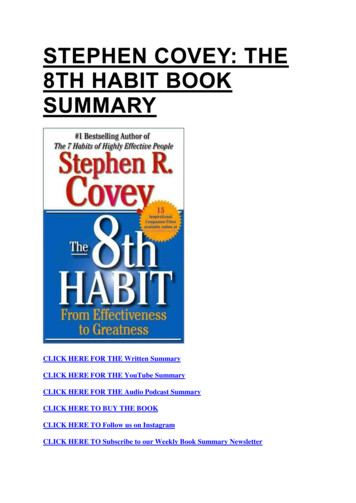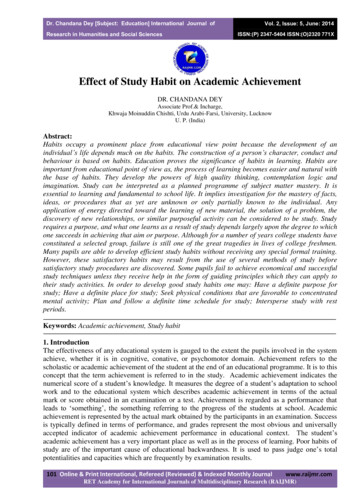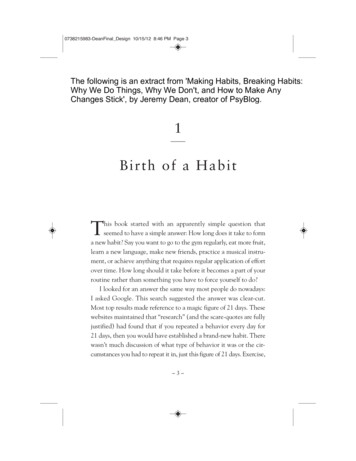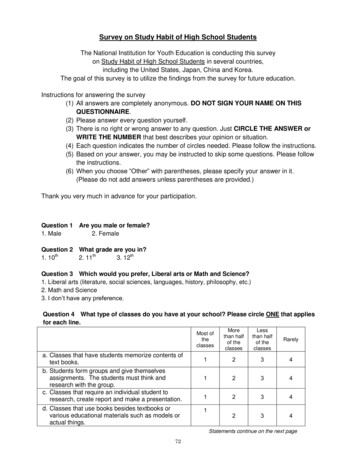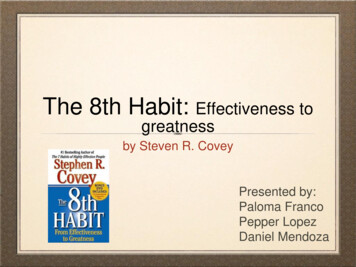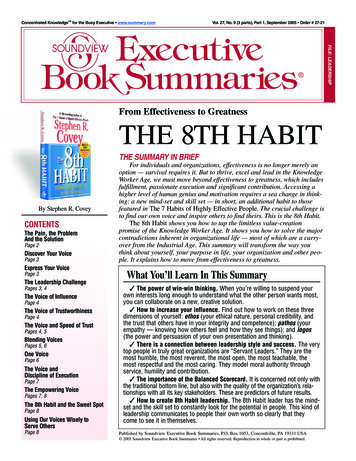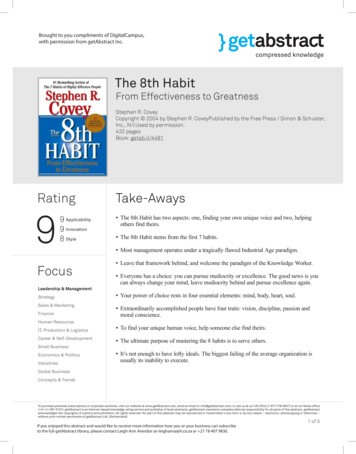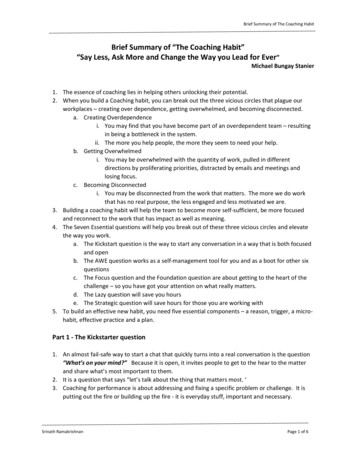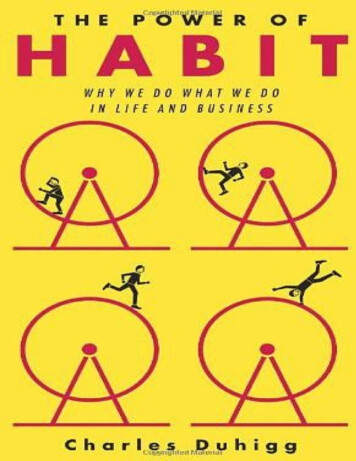
Transcription
The Power of Habit is a work of nonfiction. Nonetheless, some names andpersonal characteristics of individuals or events have been changed in order todisguise identities. Any resulting resemblance to persons living or dead isentirely coincidental and unintentional.Copyright 2012 by Charles DuhiggAll rights reserved.Published in the United States by Random House, an imprint ofThe Random House Publishing Group, a division of Random House, Inc.,New York.RANDOM HOUSE and colophon are registered trademarks of RandomHouse, Inc.Library of Congress Cataloging-in-Publication DataDuhigg, Charles.The power of habit : why we do what we do in life and business / byCharles Duhigg.p. cm.Includes bibliographical references and index.eISBN: 978-0-679-60385-61. Habit. 2. Habit—Social aspects. 3. Change (Psychology) I. Title.BF335.D76 2012
158.1—dc232011029545Illustration on this page by Andrew PoleAll other illustrations by Anton Ioukhnovetswww.atrandom.comv3.1CONTENTSCoverTitle PageCopyrightDedication
PROLOGUEThe Habit CurePART ONEThe Habits of Individuals1. THE HABIT LOOPHow Habits Work2. THE CRAVING BRAINHow to Create New Habits3. THE GOLDEN RULE OF HABIT CHANGEWhy Transformation OccursPART TWOThe Habits of Successful Organizations
4. KEYSTONE HABITS, OR THE BALLAD OF PAUL O’NEILLWhich Habits Matter Most5. STARBUCKS AND THE HABIT OF SUCCESSWhen Willpower Becomes Automatic6. THE POWER OF A CRISISHow Leaders Create Habits Through Accidentand Design7. HOW TARGET KNOWS WHAT YOU WANT BEFORE YOU DOWhen Companies Predict (and Manipulate) HabitsPART THREEThe Habits of Societies8. SADDLEBACK CHURCH AND THEMONTGOMERY BUS BOYCOTTHow Movements Happen9. THE NEUROLOGY OF FREE WILL
Are We Responsible for Our Habits?APPENDIXA Reader’s Guide to Using These IdeasAcknowledgmentsA Note on SourcesNotesPROLOGUEThe Habit CureShe was the scientists’ favorite participant.Lisa Allen, according to her file, was thirty-four years old, had startedsmoking and drinking when she was sixteen, and had struggled with obesity formost of her life. At one point, in her mid-twenties, collection agencies werehounding her to recover 10,000 in debts. An old résumé listed her longest jobas lasting less than a year.The woman in front of the researchers today, however, was lean and vibrant,with the toned legs of a runner. She looked a decade younger than the photos inher chart and like she could out-exercise anyone in the room. According to themost recent report in her file, Lisa had no outstanding debts, didn’t drink, andwas in her thirty-ninth month at a graphic design firm.“How long since your last cigarette?” one of the physicians asked, startingdown the list of questions Lisa answered every time she came to this laboratoryoutside Bethesda, Maryland.“Almost four years,” she said, “and I’ve lost sixty pounds and run amarathon since then.” She’d also started a master’s degree and bought a home. Ithad been an eventful stretch.The scientists in the room included neurologists, psychologists, geneticists,and a sociologist. For the past three years, with funding from the NationalInstitutes of Health, they had poked and prodded Lisa and more than two dozenother former smokers, chronic overeaters, problem drinkers, obsessive shoppers,
and people with other destructive habits. All of the participants had one thing incommon: They had remade their lives in relatively short periods of time. Theresearchers wanted to understand how. So they measured subjects’ vital signs,installed video cameras inside their homes to watch their daily routines,sequenced portions of their DNA, and, with technologies that allowed them topeer inside people’s skulls in real time, watched as blood and electrical impulsesflowed through their brains while they were exposed to temptations such ascigarette smoke and lavish meals.prl.1 The researchers’ goal was to figure outhow habits work on a neurological level—and what it took to make themchange.“I know you’ve told this story a dozen times,” the doctor said to Lisa, “butsome of my colleagues have only heard it secondhand. Would you minddescribing again how you gave up cigarettes?”“Sure,” Lisa said. “It started in Cairo.” The vacation had been something ofa rash decision, she explained. A few months earlier, her husband had comehome from work and announced that he was leaving her because he was in lovewith another woman. It took Lisa a while to process the betrayal and absorb thefact that she was actually getting a divorce. There was a period of mourning,then a period of obsessively spying on him, following his new girlfriend aroundtown, calling her after midnight and hanging up. Then there was the eveningLisa showed up at the girlfriend’s house, drunk, pounding on her door andscreaming that she was going to burn the condo down.“It wasn’t a great time for me,” Lisa said. “I had always wanted to see thepyramids, and my credit cards weren’t maxed out yet, so ”On her first morning in Cairo, Lisa woke at dawn to the sound of the call toprayer from a nearby mosque. It was pitch black inside her hotel room. Halfblind and jet-lagged, she reached for a cigarette.She was so disoriented that she didn’t realize—until she smelled burningplastic—that she was trying to light a pen, not a Marlboro. She had spent thepast four months crying, binge eating, unable to sleep, and feeling ashamed,helpless, depressed, and angry, all at once. Lying in bed, she broke down. “It waslike this wave of sadness,” she said. “I felt like everything I had ever wanted hadcrumbled. I couldn’t even smoke right.“And then I started thinking about my ex-husband, and how hard it wouldbe to find another job when I got back, and how much I was going to hate it andhow unhealthy I felt all the time. I got up and knocked over a water jug and itshattered on the floor, and I started crying even harder. I felt desperate, like I hadto change something, at least one thing I could control.”
She showered and left the hotel. As she rode through Cairo’s rutted streetsin a taxi and then onto the dirt roads leading to the Sphinx, the pyramids of Giza,and the vast, endless desert around them, her self-pity, for a brief moment, gaveway. She needed a goal in her life, she thought. Something to work toward.So she decided, sitting in the taxi, that she would come back to Egypt andtrek through the desert.It was a crazy idea, Lisa knew. She was out of shape, overweight, with nomoney in the bank. She didn’t know the name of the desert she was looking at orif such a trip was possible. None of that mattered, though. She needed somethingto focus on. Lisa decided that she would give herself one year to prepare. And tosurvive such an expedition, she was certain she would have to make sacrifices.In particular, she would need to quit smoking.When Lisa finally made her way across the desert eleven months later—inan air-conditioned and motorized tour with a half-dozen other people, mind you—the caravan carried so much water, food, tents, maps, global positioningsystems, and two-way radios that throwing in a carton of cigarettes wouldn’thave made much of a difference.But in the taxi, Lisa didn’t know that. And to the scientists at the laboratory,the details of her trek weren’t relevant. Because for reasons they were justbeginning to understand, that one small shift in Lisa’s perception that day inCairo—the conviction that she had to give up smoking to accomplish her goal—had touched off a series of changes that would ultimately radiate out to everypart of her life. Over the next six months, she would replace smoking withjogging, and that, in turn, changed how she ate, worked, slept, saved money,scheduled her workdays, planned for the future, and so on. She would startrunning half-marathons, and then a marathon, go back to school, buy a house,and get engaged. Eventually she was recruited into the scientists’ study, andwhen researchers began examining images of Lisa’s brain, they saw somethingremarkable: One set of neurological patterns—her old habits—had beenoverridden by new patterns. They could still see the neural activity of her oldbehaviors, but those impulses were crowded out by new urges. As Lisa’s habitschanged, so had her brain.It wasn’t the trip to Cairo that had caused the shift, scientists wereconvinced, or the divorce or desert trek. It was that Lisa had focused onchanging just one habit—smoking—at first. Everyone in the study had gonethrough a similar process. By focusing on one pattern—what is known as a“keystone habit”—Lisa had taught herself how to reprogram the other routinesin her life, as well.
It’s not just individuals who are capable of such shifts. When companiesfocus on changing habits, whole organizations can transform. Firms such asProcter & Gamble, Starbucks, Alcoa, and Target have seized on this insight toinfluence how work gets done, how employees communicate, and—withoutcustomers realizing it—the way people shop.“I want to show you one of your most recent scans,” a researcher told Lisanear the end of her exam. He pulled up a picture on a computer screen thatshowed images from inside her head. “When you see food, these areas”—hepointed to a place near the center of her brain—“which are associated withcraving and hunger, are still active. Your brain still produces the urges that madeyou overeat.“However, there’s new activity in this area”—he pointed to the regionclosest to her forehead—“where we believe behavioral inhibition and selfdiscipline starts. That activity has become more pronounced each time you’vecome in.”Lisa was the scientists’ favorite participant because her brain scans were socompelling, so useful in creating a map of where behavioral patterns—habits—reside within our minds. “You’re helping us understand how a decision becomesan automatic behavior,” the doctor told her.Everyone in the room felt like they were on the brink of somethingimportant. And they were.When you woke up this morning, what did you do first? Did you hop in theshower, check your email, or grab a doughnut from the kitchen counter? Did youbrush your teeth before or after you toweled off? Tie the left or right shoe first?What did you say to your kids on your way out the door? Which route did youdrive to work? When you got to your desk, did you deal with email, chat with acolleague, or jump into writing a memo? Salad or hamburger for lunch? Whenyou got home, did you put on your sneakers and go for a run, or pour yourself adrink and eat dinner in front of the TV?“All our life, so far as it has definite form, is but a mass of habits,” WilliamJames wrote in 1892.prl.2 Most of the choices we make each day may feel likethe products of well-considered decision making, but they’re not. They’re habits.And though each habit means relatively little on its own, over time, the meals we
order, what we say to our kids each night, whether we save or spend, how oftenwe exercise, and the way we organize our thoughts and work routines haveenormous impacts on our health, productivity, financial security, and happiness.One paper published by a Duke University researcher in 2006 found that morethan 40 percent of the actions people performed each day weren’t actualdecisions, but habits.prl.3William James—like countless others, from Aristotle to Oprah—spent muchof his life trying to understand why habits exist. But only in the past two decadeshave scientists and marketers really begun understanding how habits work—andmore important, how they change.This book is divided into three parts. The first section focuses on how habitsemerge within individual lives. It explores the neurology of habit formation, howto build new habits and change old ones, and the methods, for instance, that onead man used to push toothbrushing from an obscure practice into a nationalobsession. It shows how Procter & Gamble turned a spray named Febreze into abillion-dollar business by taking advantage of consumers’ habitual urges, howAlcoholics Anonymous reforms lives by attacking habits at the core of addiction,and how coach Tony Dungy reversed the fortunes of the worst team in theNational Football League by focusing on his players’ automatic reactions tosubtle on-field cues.The second part examines the habits of successful companies andorganizations. It details how an executive named Paul O’Neill—before hebecame treasury secretary—remade a struggling aluminum manufacturer into thetop performer in the Dow Jones Industrial Average by focusing on one keystonehabit, and how Starbucks turned a high school dropout into a top manager byinstilling habits designed to strengthen his willpower. It describes why even themost talented surgeons can make catastrophic mistakes when a hospital’sorganizational habits go awry.The third part looks at the habits of societies. It recounts how Martin LutherKing, Jr., and the civil rights movement succeeded, in part, by changing theingrained social habits of Montgomery, Alabama—and why a similar focushelped a young pastor named Rick Warren build the nation’s largest church inSaddleback Valley, California. Finally, it explores thorny ethical questions, suchas whether a murderer in Britain should go free if he can convincingly argue thathis habits led him to kill.Each chapter revolves around a central argument: Habits can be changed, ifwe understand how they work.This book draws on hundreds of academic studies, interviews with more
than three hundred scientists and executives, and research conducted at dozensof companies. (For an index of resources, please see the book’s notes andhttp://www.thepowerofhabit.com.) It focuses on habits as they are technicallydefined: the choices that all of us deliberately make at some point, and then stopthinking about but continue doing, often every day. At one point, we allconsciously decided how much to eat and what to focus on when we got to theoffice, how often to have a drink or when to go for a jog. Then we stoppedmaking a choice, and the behavior became automatic. It’s a natural consequenceof our neurology. And by understanding how it happens, you can rebuild thosepatterns in whichever way you choose.I first became interested in the science of habits eight years ago, as anewspaper reporter in Baghdad. The U.S. military, it occurred to me as I watchedit in action, is one of the biggest habit-formation experiments in history.prl.4Basic training teaches soldiers carefully designed habits for how to shoot, think,and communicate under fire. On the battlefield, every command that’s issueddraws on behaviors practiced to the point of automation. The entire organizationrelies on endlessly rehearsed routines for building bases, setting strategicpriorities, and deciding how to respond to attacks. In those early days of the war,when the insurgency was spreading and death tolls were mounting, commanderswere looking for habits they could instill among soldiers and Iraqis that mightcreate a durable peace.I had been in Iraq for about two months when I heard about an officerconducting an impromptu habit modification program in Kufa, a small cityninety miles south of the capital. He was an army major who had analyzedvideotapes of recent riots and had identified a pattern: Violence was usuallypreceded by a crowd of Iraqis gathering in a plaza or other open space and, overthe course of several hours, growing in size. Food vendors would show up, aswell as spectators. Then, someone would throw a rock or a bottle and all hellwould break loose.When the major met with Kufa’s mayor, he made an odd request: Couldthey keep food vendors out of the plazas? Sure, the mayor said. A few weekslater, a small crowd gathered near the Masjid al-Kufa, or Great Mosque of Kufa.Throughout the afternoon, it grew in size. Some people started chanting angry
slogans. Iraqi police, sensing trouble, radioed the base and asked U.S. troops tostand by. At dusk, the crowd started getting restless and hungry. People lookedfor the kebab sellers normally filling the plaza, but there were none to be found.The spectators left. The chanters became dispirited. By 8 P.M., everyone wasgone.When I visited the base near Kufa, I talked to the major. You wouldn’tnecessarily think about a crowd’s dynamics in terms of habits, he told me. But hehad spent his entire career getting drilled in the psychology of habit formation.At boot camp, he had absorbed habits for loading his weapon, falling asleepin a war zone, maintaining focus amid the chaos of battle, and making decisionswhile exhausted and overwhelmed. He had attended classes that taught himhabits for saving money, exercising each day, and communicating withbunkmates. As he moved up the ranks, he learned the importance oforganizational habits in ensuring that subordinates could make decisions withoutconstantly asking permission, and how the right routines made it easier to workalongside people he normally couldn’t stand. And now, as an impromptu nationbuilder, he was seeing how crowds and cultures abided by many of the samerules. In some sense, he said, a community was a giant collection of habitsoccurring among thousands of people that, depending on how they’re influenced,could result in violence or peace. In addition to removing the food vendors, hehad launched dozens of different experiments in Kufa to influence residents’habits. There hadn’t been a riot since he arrived.“Understanding habits is the most important thing I’ve learned in the army,”the major told me. “It’s changed everything about how I see the world. You wantto fall asleep fast and wake up feeling good? Pay attention to your nighttimepatterns and what you automatically do when you get up. You want to makerunning easy? Create triggers to make it a routine. I drill my kids on this stuff.My wife and I write out habit plans for our marriage. This is all we talk about incommand meetings. Not one person in Kufa would have told me that we couldinfluence crowds by taking away the kebab stands, but once you see everythingas a bunch of habits, it’s like someone gave you a flashlight and a crowbar andyou can get to work.”The major was a small man from Georgia. He was perpetually spitting eithersunflower seeds or chewing tobacco into a cup. He told me that prior to enteringthe military, his best career option had been repairing telephone lines, or,possibly, becoming a methamphetamine entrepreneur, a path some of his highschool peers had chosen to less success. Now, he oversaw eight hundred troopsin one of the most sophisticated fighting organizations on earth.
“I’m telling you, if a hick like me can learn this stuff, anyone can. I tell mysoldiers all the time, there’s nothing you can’t do if you get the habits right.”In the past decade, our understanding of the neurology and psychology ofhabits and the way patterns work within our lives, societies, and organizationshas expanded in ways we couldn’t have imagined fifty years ago. We now knowwhy habits emerge, how they change, and the science behind their mechanics.We know how to break them into parts and rebuild them to our specifications.We understand how to make people eat less, exercise more, work moreefficiently, and live healthier lives. Transforming a habit isn’t necessarily easy orquick. It isn’t always simple.But it is possible. And now we understand how.THE HABIT LOOPHow Habits WorkI.In the fall of 1993, a man who would upend much of what we know abouthabits walked into a laboratory in San Diego for a scheduled appointment. Hewas elderly, a shade over six feet tall, and neatly dressed in a blue button-downshirt.1.1 His thick white hair would have inspired envy at any fiftieth high schoolreunion. Arthritis caused him to limp slightly as he paced the laboratory’shallways, and he held his wife’s hand, walking slowly, as if unsure about whateach new step would bring.About a year earlier, Eugene Pauly, or “E.P.” as he would come to be knownin medical literature, had been at home in Playa del Rey, preparing for dinner,when his wife mentioned that their son, Michael, was coming over.“Who’s Michael?” Eugene asked.1.2
“Your child,” said his wife, Beverly. “You know, the one we raised?”Eugene looked at her blankly. “Who is that?” he asked.The next day, Eugene started vomiting and writhing with stomach cramps.Within twenty-four hours, his dehydration was so pronounced that a panickedBeverly took him to the emergency room. His temperature started rising, hitting105 degrees as he sweated a yellow halo of perspiration onto the hospital’ssheets. He became delirious, then violent, yelling and pushing when nurses triedto insert an IV into his arm. Only after sedation was a physician able to slide along needle between two vertebra in the small of his back and extract a fewdrops of cerebrospinal fluid.The doctor performing the procedure sensed trouble immediately. The fluidsurrounding the brain and spinal nerves is a barrier against infection and injury.In healthy individuals, it is clear and quick flowing, moving with an almost silkyrush through a needle. The sample from Eugene’s spine was cloudy and drippedout sluggishly, as if filled with microscopic grit.1.3 When the results came backfrom the laboratory, Eugene’s physicians learned why he was ill: He wassuffering from viral encephalitis, a disease caused by a relatively harmless virusthat produces cold sores, fever blisters, and mild infections on the skin. In rarecases, however, the virus can make its way into the brain, inflicting catastrophicdamage as it chews through the delicate folds of tissue where our thoughts,dreams—and according to some, souls—reside.Eugene’s doctors told Beverly there was nothing they could do to counterthe damage already done, but a large dose of antiviral drugs might prevent itfrom spreading. Eugene slipped into a coma and for ten days was close to death.Gradually, as the drugs fought the disease, his fever receded and the virusdisappeared. When he finally awoke, he was weak and disoriented and couldn’tswallow properly. He couldn’t form sentences and would sometimes gasp, as ifhe had momentarily forgotten how to breathe. But he was alive.Eventually, Eugene was well enough for a battery of tests. The doctors wereamazed to find that his body—including his nervous system—appeared largelyunscathed. He could move his limbs and was responsive to noise and light.Scans of his head, though, revealed ominous shadows near the center of hisbrain. The virus had destroyed an oval of tissue close to where his cranium andspinal column met. “He might not be the person you remember,” one doctorwarned Beverly. “You need to be ready if your husband is gone.”Eugene was moved to a different wing of the hospital. Within a week, hewas swallowing easily. Another week, and he started talking normally, asking forJell-O and salt, flipping through television channels and complaining about
boring soap operas. By the time he was discharged to a rehabilitation center fiveweeks later, Eugene was walking down hallways and offering nurses unsolicitedadvice about their weekend plans.“I don’t think I’ve ever seen anyone come back like this,” a doctor toldBeverly. “I don’t want to raise your hopes, but this is amazing.”Beverly, however, remained concerned. In the rehab hospital it became clearthat the disease had changed her husband in unsettling ways. Eugene couldn’tremember which day of the week it was, for instance, or the names of his doctorsand nurses, no matter how many times they introduced themselves. “Why dothey keep asking me all these questions?” he asked Beverly one day after aphysician left his room. When he finally returned home, things got even stranger.Eugene didn’t seem to remember their friends. He had trouble followingconversations. Some mornings, he would get out of bed, walk into the kitchen,cook himself bacon and eggs, then climb back under the covers and turn on theradio. Forty minutes later, he would do the same thing: get up, cook bacon andeggs, climb back into bed, and fiddle with the radio. Then he would do it again.Alarmed, Beverly reached out to specialists, including a researcher at theUniversity of California, San Diego, who specialized in memory loss. Which ishow, on a sunny fall day, Beverly and Eugene found themselves in a nondescriptbuilding on the university’s campus, holding hands as they walked slowly downa hallway. They were shown into a small exam room. Eugene began chattingwith a young woman who was using a computer.“Having been in electronics over the years, I’m amazed at all this,” he said,gesturing at the machine she was typing on. “When I was younger, that thingwould have been in a couple of six-foot racks and taken up this whole room.”The woman continued pecking at the keyboard. Eugene chuckled.“That is incredible,” he said. “All those printed circuits and diodes andtriodes. When I was in electronics, there would have been a couple of six-footracks holding that thing.”A scientist entered the room and introduced himself. He asked Eugene howold he was.“Oh, let’s see, fifty-nine or sixty?” Eugene replied. He was seventy-oneyears old.The scientist started typing on the computer. Eugene smiled and pointed atit. “That is really something,” he said. “You know, when I was in electronicsthere would have been a couple of six-foot racks holding that thing!”The scientist was fifty-two-year-old Larry Squire, a professor who had spent
the past three decades studying the neuroanatomy of memory. His specialty wasexploring how the brain stores events. His work with Eugene, however, wouldsoon open a new world to him and hundreds of other researchers who havereshaped our understanding of how habits function. Squire’s studies would showthat even someone who can’t remember his own age or almost anything else candevelop habits that seem inconceivably complex—until you realize thateveryone relies on similar neurological processes every day. His and others’research would help reveal the subconscious mechanisms that impact thecountless choices that seem as if they’re the products of well-reasoned thought,but actually are influenced by urges most of us barely recognize or understand.By the time Squire met Eugene, he had already been studying images of hisbrain for weeks. The scans indicated that almost all the damage within Eugene’sskull was limited to a five-centimeter area near the center of his head. The virushad almost entirely destroyed his medial temporal lobe, a sliver of cells whichscientists suspected was responsible for all sorts of cognitive tasks such as recallof the past and the regulation of some emotions. The completeness of thedestruction didn’t surprise Squire—viral encephalitis consumes tissue with aruthless, almost surgical, precision. What shocked him was how familiar theimages seemed.Thirty years earlier, as a PhD student at MIT, Squire had worked alongside agroup studying a man known as “H.M.,” one of the most famous patients inmedical history. When H.M.—his real name was Henry Molaison, but scientistsshrouded his identity throughout his life—was seven years old, he was hit by abicycle and landed hard on his head.1.4, 1.5, 1.6 Soon afterward, he developedseizures and started blacking out. At sixteen, he had his first grand mal seizure,the kind that affects the entire brain; soon, he was losing consciousness up to tentimes a day.By the time he turned twenty-seven, H.M. was desperate. Anticonvulsivedrugs hadn’t helped. He was smart, but couldn’t hold a job.1.7 He still lived withhis parents. H.M. wanted a normal existence. So he sought help from a physicianwhose tolerance for experimentation outweighed his fear of malpractice. Studieshad suggested that an area of the brain called the hippocampus might play a rolein seizures. When the doctor proposed cutting into H.M.’s head, lifting up thefront portion of his brain, and, with a small straw, sucking out the hippocampusand some surrounding tissue from the interior of his skull, H.M.1.8, 1.9 gave hisconsent.The surgery occurred in 1953, and as H.M. healed, his seizures slowed.Almost immediately, however, it became clear that his brain had been radically
altered. H.M. knew his name and that his mother was from Ireland. He couldremember the 1929 stock market crash and news reports about the invasion ofNormandy. But almost everything that came afterward—all the memories,experiences, and struggles from most of the decade before his surgery—hadbeen erased. When a doctor began testing H.M.’s memory by showing himplaying cards and lists of numbers, he discovered that H.M. couldn’t retain anynew information for more than twenty seconds or so.From the day of his surgery until his death in 2008, every person H.M. met,every song he heard, every room he entered, was a completely fresh experience.His brain was frozen in time. Each day, he was befuddled by the fact thatsomeone could change the television channel by pointing a black rectangle ofplastic at the screen. He introduced himself to his doctors and nurses over andover, dozens of times each day.1.10“I loved learning about H.M., because memory seemed like such a tangible,exciting way to study the brain,” Squire told me. “I grew up in Ohio, and I canremember, in first grade, my teacher handing everyone crayons, and I startedmixing all the colors together to see if it would make black. Why have I kept thatmemory, but I can’t remember what my teacher looked like? Why does my braindecide that one memory is more important than another?”When Squire received the images of Eugene’s brain, he marveled at howsimilar it seemed to H.M.’s. There were empty, walnut-sized chunks in themiddle of both their heads. Eugene’s memory—just like H.M.’s—had beenremoved.As Squire began examining Eugene, though, he saw that this patient wasdifferent from H.M. in some profound ways. Whereas almost everyone knewwithin minutes of meeting H.M. that something was amiss, Eugene could carryon conversations and perform tasks that wouldn’t alert a casual observer thatanything was wrong. The effects of H.M.’
The Power of Habit is a work of nonfiction. Nonetheless, some names and personal characteristics of individuals or events have been changed in order to disguise identities. Any resulting resemblance to persons l
